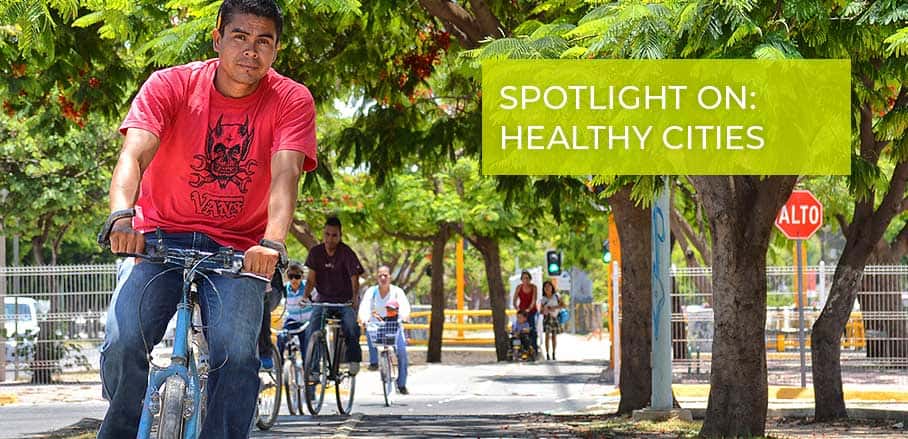Green Infrastructure in Mexico: A Booster for Healthier Cities
Citizens of Mexico City face serious health issues – due to failures in urban planning, says Auribel Villa. Green infrastructure development significantly supports cities’ ways towards becoming healthier and thus more liveable.
Liveable Cities are Healthy Cities
Over the years, a great number of properties have been defined in order to reflect on the concept of a liveable city: smart, green, resilient, human, sustainable, ecologic, biophilic and many more. Among them, the idea that a liveable city has to be a healthy city has been underrated despite its relevance. After and above all, cities are their citizens. People choose to live in cities based on the countless opportunities the cities have to offer, be they social, economic, educational, or recreational. But if cities are incapable of assuring their citizens’ health, all their other assets are pointless.
Urban Planning is Key to Healthy Cities
There are many aspects, a lot of them intertwined, that contribute to a healthy lifestyle. Highly important among them are the rates of physical activity and air quality. Both aspects pose problems in Mexican cities.
Obviously, a lot of factors are drivers of this trend. The question is, if the way we design our cities has something to do with it –I think it does. Urban growth patterns and the lack of open spaces contribute to an unhealthy urban environment. So, it is clear that something has gone wrong in the way we have been planning our cities.
According to the report “The Mexicans’ Health”, the rate of physical inactivity in Mexico is quite high. More than 20 per cent of women and 13 per cent of men between 15 and 29 and 29 per cent of people between 15 and 19 live a sedentary lifestyle. Looking at this data, it is not surprising that the number of obese adults has increased from 63.8 per cent in 2000 to 71.3 per cent in 2012.
Take a look at urban areas like Mexico City: citizens can spend up to four hours to get to their workplaces. Such urban expansion makes it almost impossible to move from one point to another without depending on your car. When people have finally arrived at their home after hours spent in traffic, they have no motivation to take a walk in their neighbourhood. Even if there was still energy left for taking a walk in the evening, this would be destroyed by the poor condition of the sidewalks: uneven levels, invaded by all kinds of stuff, from trees’ surfacing roots to abandoned furniture.
Another big health issue among Mexicans is respiratory illnesses related to poor air quality in our cities. A major cause of air pollution is the massive usage of private cars as a result of uncontrolled urban expansion forcing people to rely on their cars for transport.
Approaching the Problem with Green Infrastructure
These considerations do not make for a very nice perspective on the future of Mexican cities; it seems hardly possible to find a way that can address these challenges with the limited resources available to the cities.
That’s exactly why the team of the Cities and Climate Change Programme (CiClim) is so excited about promoting Green Infrastructure. Green Infrastructure is defined by the European Commission as “a strategically planned network of natural and semi-natural areas with other environmental features designed and managed to deliver a wide range of ecosystem services’ in both rural and urban settings”.
The Many Benefits of Green Infrastructure
While there are different kind of climates in Mexico, there are generally great conditions for greenery. After all, Mexico is a megadiverse country, and Green Infrastructure could be a way to preserve those species that have adapted to urban conditions. Beyond its contribution to urban biodiversity and nature restoration, Green Infrastructure could be a key to healthier, happier cities, tackling both the problems of physical (in)activity and air quality.
Vegetation helps to regulate exposure to weather, bringing shade on sunny days or serving as wind barriers on colder ones. A tree-lined street could be a driver to promote active mobility – that is why at CiClim, we want to conceive complete streets lined by the green element. Furthermore, a good selection of plants and trees can reduce pollution due to the trees’ capacity to absorb CO2 and inhalable particles from the air.
According to Lee and Maheswaran, “one postulated mechanism by which green space influences physical health is through its effect on physical activity levels. Modification of the built environment to provide green space offers opportunities for beneficial ‘green exercise’ such as walking.” This holds also true for cycling. We have noticed that a cycle lane surrounded by trees and vegetation is more likely to be used, especially on sunny days, than an arid track.
The benefits of shade and climate regulation provided by greenery is a key aspect that can influence people’s mobility choices towards preferring to walk or ride across little and medium distances instead of using their cars.
Making Green Infrastructure a Common Practice
Some isolated efforts in these regards have already been made in several cities, for example the Design Guidelines for Green Infrastructure in Hermosillo, the Design Guide in Ciudad Juárez, and the Municipal Plan on Green Infrastructure in Merida. Our goal is to help these cities to further improve their initiatives and to measure and to increase their benefits. We aim at exchanging experiences between cities in Mexico and other Latin American countries. Another task is to find innovative ways to fund these projects.
We are confident that with a strong cooperation among different actors, we can make Green Infrastructure a common practice in Mexican cities – lastingly contributing to healthy, liveable cities.
- Green Infrastructure in Mexico: A Booster for Healthier Cities - 17. October 2018
- Urban Regeneration: Viewpoints of a Mexican City - 12. September 2018
